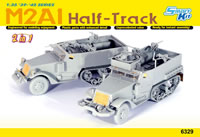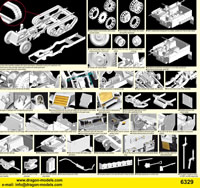|
DML
6329 BackgroundIn
1959, Monogram came out with two kits of the famous WWII half-track—the M3A1
with the M49 ring mount, and the M13 twin .50 caliber Maxson gun turret. Both
were typical of the kits of the day, with heavy "working" drivelines
(that never really worked, as the tracks would either snap or fly off!) and many
"working features" such as operating doors, moving machine guns, and,
in the case of the M13, a working turret. While billed as "3/8 inch scale"
(or 1/32) they were actually accurate 1/35 scale kits. Both came with figures
(five with the M13, nine with the M3A1) and cost all of $1.49 each. They remained
popular with modelers even with all of their flaws, as they were for many years
the only game in town. Stray
kits came out from other companies, such as an odd T19 with "working"
105mm howitzer from Palmer Plastics in 1/24 (or so) scale and some Japanese clones
with motors installed, as well as 1/87 ones from ROCO and 1/76 ones from Airfix.
But it was not until 1975 that Tamiya released another large-scale kit with their
M3A2 and U.S. Infantry Set. Unfortunately
the Tamiya kit was surprisingly little different than the Monogram kit from 17
years earlier, as it had a very similar suspension and interior with only more
accurate doors and chassis to differentiate the two. The figures here required
assembly (Monogram's did not, but they were also armed with M14s and not WWII
M1s) but overall it was a disappointing kit. To add insult to injury, rather than
make the more common and combat veteran M3 or M3A1, they picked a prototype that
was to replace both the M2 and M3 series with one vehicle, but never got into
production. Never
one to give up on a good set of molds, Tamiya later released an M21 81mm mortar
carrier and the most useful of the family, the M16 quadruple .50 caliber MGMC.
But the basic chassis and hull problems remained. Nevertheless, these three kits
kept a number of after-market manufacturers busy for 30 years making etched brass
or resin components to replace the suspension, tracks and hull components. No
more. After several years of heavy prodding by people like myself, DML has now
turned its attention to the American half-tracks of WWII. The first of what promises
to be a healthy series is a two-in-one kit that permits the modeler to either
build the early war M2 or the late war M2A1 from a single kit. For
those people not familiar with the M2 series half-tracks, they were nearly identical
to the better known M3 series used by the armored infantry units in armored divisions
but were special purpose vehicles that were designed for use by other elements.
Two of the major users of this version were armored engineers and antitank artillery
battalions. To that end, the M2 had two large stowage bins, one on each side of
the hull behind the cab of the vehicle, and special racks as needed inside for
stowage of essential items. The M2 later received add-on accessories such as jerry
can racks for water or fuel and racks for mines on the sides of the body. The
major difference between the M2 and M2A1 was the replacement of the weapons mounting
system inside the hull, better known as a "skate rail," with multiple
machine gun mounts sliding on it, with a more practical M49 ring mount above the
co-driver/commander's position on the right side of the cab. Other
variations were incremental and could be found on either M2 or M2A1 vehicles,
moreso as many M2s were rebuilt in the field into M2A1s with the skate rail removed
and the M49 mounted instead. The three main optional features were: either a roller
or a winch, of which the roller was far more common on M2 series vehicles; automotive
style headlights mounted on the tops of the fenders, or "combat" headlights
mounted on the sides of the armored grille; and luggage racks at the rear of the
hull and mine racks, which were MWO (modification work order) items added in the
field. The
Kit I
had the privilege to see the test shot kit of this vehicle sent to Steve Zaloga,
and have the advantage of his comments on the kit before I even saw this review
example. I
had the privilege to see the test shot kit of this vehicle sent to Steve Zaloga,
and have the advantage of his comments on the kit before I even saw this review
example.
DML
has managed to cover the gamut of items and provides most of them here in one
package, and a "Smart Kit" with really amazing details as well. Four
sprues provide the parts for the chassis and drive train, including a complete
White engine and transmission. While the hood is molded in one piece, DML has
notched the back side, as well as the insides of the "cab" sides, to
permit easy cutting to open them up for display. The steering does not operate
(no big loss of oversized parts) but is very petite and neatly detailed. The
bogies and track runs are very impressive, as the idlers and drivers are slide
molded with respectively thin details and openings. (Some "boo birds"
have already complained they are too thick, but I invite them to compare them
to the Tamiya offerings first and then ask if they really want to solder the parts
together from etched brass.) Each bogie assembly consists of 18 parts and is very
petite; the mounting suspension provides five more with the track tension adjusters
nicely portrayed. The tracks are very interesting: DML molded them in hard styrene
plastic in two halves, cut in such a way that the "chain" plate drive
tooth guides in the center are represented as they are found on the actual vehicle.
Since the tracks were metal with rubber "endless belt" casings vulcanized
onto them, this is a neat way to portray it. (Steve answered one of my questions
in that they do fit on fairly easily, as they are installed at the same time as
the drivers and idlers so the entire assembly can be snugly fitted to the model.)
 The
model comes with two sets of body panels for the rear body – one with the
mounts for the skate ring and one without, based on which one you wish to do or
an upgradein the field with the skate ring mounts and the M49 ring mount. DML
provides two beautifully done .50 caliber M2HB machine guns and four equally well
done .30 caliber Brownings, all with the correct mounts (the .30s come with one
"rocker" mount and one similar to that used by the .50 for each one,
so a maximum of three .30s can be fitted to the model.) While the sides are molded
in one piece, DML has grooved the inside like the hood and provided open space
for the stowage bins if the modeler wants them opened. The
model comes with two sets of body panels for the rear body – one with the
mounts for the skate ring and one without, based on which one you wish to do or
an upgradein the field with the skate ring mounts and the M49 ring mount. DML
provides two beautifully done .50 caliber M2HB machine guns and four equally well
done .30 caliber Brownings, all with the correct mounts (the .30s come with one
"rocker" mount and one similar to that used by the .50 for each one,
so a maximum of three .30s can be fitted to the model.) While the sides are molded
in one piece, DML has grooved the inside like the hood and provided open space
for the stowage bins if the modeler wants them opened.
While
the correct folded ground tripods are included for the normal fit of two .30 and
one .50 caliber machine guns, surprisingly one of the few missing options in the
kit was the MWO luggage racks at the rear of the hull. Another item to note is
the correct WWII taillight configuration: an oval on the left top for the taillight,
a rectangle on the right top for the stop light, and two rectangles on the bottom
for the combat blackout taillights. About time! The
cab is neatly done, and two sets of grille mounts are included. One is for use
with the "Combat" light and the other with the "Automotive"
headlights. One of each is provided closed and one with the folding louvers removed
(these have to be made from etched brass, as no plastic parts are provided for
the louvers.) The model has the civilian style dashboard, so note that the instruments
are a brushed aluminum color on preserved/restored vehicles and not the more common
black with white numerals. The
winch and roller each come with their own bumper and accouterments. The winch
has a length of nylon string for the cable and a chain for the final hook arrangement,
which matches photos of wartime models in service. Note that the driveshaft for
the winch needs to be installed in Step 5! The
etched brass, as with other "Smart Kits," is held to a minimum, and
covers the headlight guards for the "automotive" version, mud flaps,
the aforementioned engine air louvers, windshield wipers, and the sliding covers
for the view slits. Other
bits include the fact it comes with the so-called potable water carrier versions
of the jerry cans with flip-up lids (the gas cans normally had screw-type caps
with better seals). The kit provides two different types of radio sets and antenna
mounts: either the SCR-508/608 type of armored troops radio set (one on each machine
gun sprue) or the more common SCR-510/610 type, racked up side-by-side rather
than tuner on top of power supply. The
model comes with three (!) Cartograf decal sheets—generic stars, generic
serial and bumper code "jungles," and a targeted set for this kit—but
the markings and finishing information is somewhat spartan. Five different vehicles
are covered: an M2 in 1st Armored Division, Italy 1944 (two color camouflage);
an M2 in 1st Armored Division, Tunisia 1942 (OD with US flags on the sides); M2,
generic U.S. Army, 1941-42 (OD with stars); M2A1, XX Corps, Belgium, 1945 (two
color camouflage); and an M2A1, generic U.S. Army, 1941-1942 (OD with stars).
I strongly suggest getting either Steve Zaloga's U.S. Half-track in Combat
1941-1945 from Concord or Jim Mesko's M3 Half-track in Action from
Squadron/Signal as they both provide a lot of photos and good information for
finishing, but there are a lot of other good books on the market covering these
popular vehicles. Overall,
this is a winner and I am very happy to see that an M3/M3A1 kit is coming right
behind it. Based on those two, the rest of the family will hopefully follow –
M4/M21 mortar carriers, M13/M14 MGMC, T28/M15/M15A1 AA half-tracks, and the various
SP models with 57mm, 75mm and 105mm weapons. A great time for American modelers
for a change! Highly
Recommended.
-------------------------------------------------------------------------------- Sprue
Breakdown A
40 Chassis and suspension
B 28 Armored cab assembly
C 29 M49 mount and
front bumper assemblies
D 48x2 Bogie assembly and wheels
E 7 Clear styrene
parts
H 4 Front grille (open/closed)
J 37x2 Machine guns and radio set
K 40 Rear body components
W 8 Slide molded drivers and idlers
MA 23 Etched
brass
MC 1 brass chain
MD 1 nylon string Thanks
to Freddie Leung for the review sample.
—Cookie
Sewell | 











